We all know that the shove knife can be a very useful tool during non-emergent runs, like automatic fire alarms (AFA) . They are commonly used to gain entry into rooms that have an outward swinging door with a simple “slam latch”.
How many times have you responded to an AFA and found the Fire Alarm Control Panel (FACP) locked inside a room with no key to be found? How about an elevator equipment room or an electrical room, all locked and missing keys? A majority of the time these rooms will have an outward swinging door with a “slam latch”. A perfect way to defeat this type of door, with zero damage, is the use of a shove knife. Like any tool, shove knives have their limitations and knowing ways to overcome them will set us up for success. One drawback is not being able to “shove” a door when a latch guard is present. The latch guard is installed to keep intruders from using the shove knife concept and defeating the lock. Unfortunately for us, this eliminates the potential to utilize a shove knife as well… Until now.
An easy way to shove this type of door and overcome the latch guard is the use a 24 inch piece of weed-eater cord. Start by fishing the cord down from above the guard and behind the latch. The nice thing about weed eater cord is that is maintains a bit of a “memory” when unrolled it will still have a natural arc that helps get it into place behind the latch.
Next, pull the cord out from the bottom of the guard, you should now have the cord wrapped behind the latch.
Finally, pull both top and bottom ends of the cord towards you while doing an up and down sawing motion til the door pops open. Hint:Â Placing a little pressure on the door with your foot makes fishing the line in place easier because it allows the latch to sit properly in its keeper.
This technique is surprisingly simple, but of course we recommend practicing on doors at the firehouse. The technique works just as well on doors without latch guards. Keep in mind that some doors are placed so tight into the frame that you may not have the room to fish the cord into place or defeat a tamper pin. Most slam latches are accompanied with a tamper pin. The tamper pin is the small semi-circle pin located adjacent to the slam latch (see photo above). The tamper pin works by staying outside the latch keeper causing it to be depressed when the door is closed. When the tamper pin is engaged it is intended to prevent the ability to manipulated the lock with items like shove knives and weed-eater cords. Confused? Find a door with a slam latch and tamper pin, open the door and press the tamper pin towards the door and you’ll find that the slam latch will not move inward. Now let the pin extend back out and notice the slam latch operates properly. When you place inward pressure on the door with your foot we are trying to push the tamper pin into the keeper (allowing it to fully extend) thus defeating the pin.
One benefit about weed-eater cord is that it’s cheap and light. It can be easily carried rolled up in your coat pocket without taking up any room or adding noticeable weight. While this technique might not work on every latch guard installation you come across, it is a simple and effective way to defeat most of them.

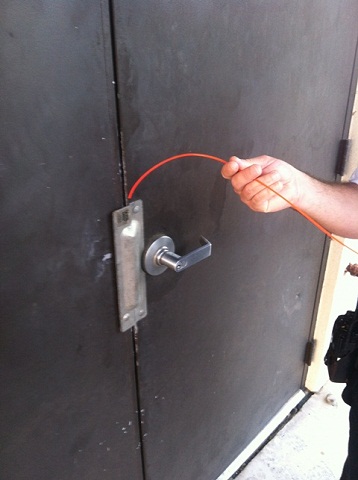
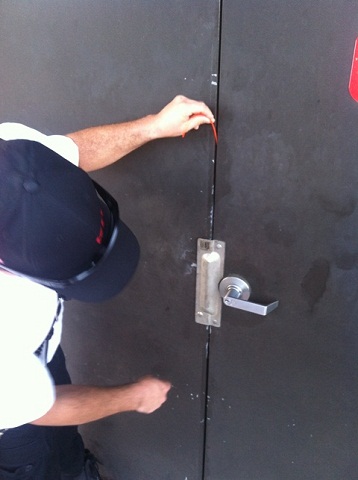
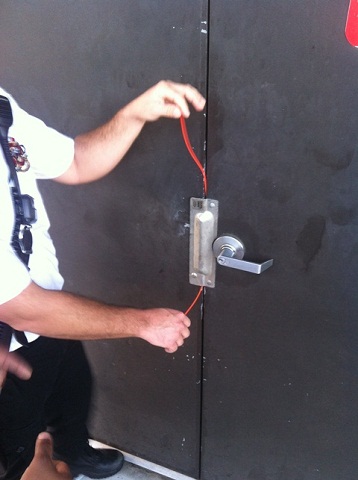
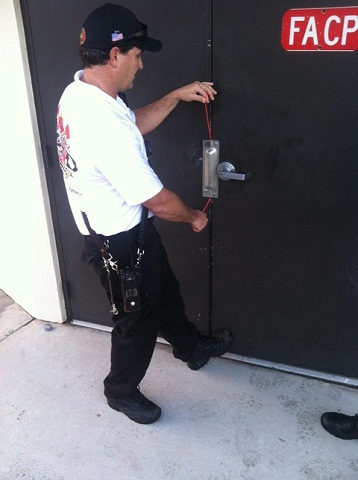
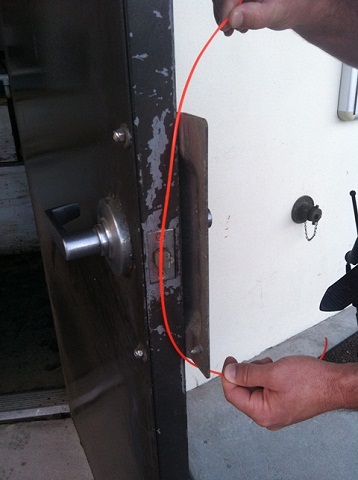
Never really thought about weed eater cord before. I have used a bougie and ET tube stylet before when riding the ambulance because it was available, but this is definitely a cheaper option.
Great idea! I’ll be trying this out.
Great idea. My daughter (13) showed me this trick with a piece of ribbon tied to a safety pin. She used a magnet to retrieve the pin from between the door and jamb.
Yea old trick, but new material.
If the foot pressure doesn’t get the tamper (or “anti-loiter”) pin to go into the keeper, many times a small bump/hit to the door just above or below the latch will do the trick. Thankfully in our area, a lot of these latches were either installed properly, or have worn over time. Never done it with trimmer line, though. Cool idea.
*improperly
I like it. Only real downside I found from playing around with it at the station is that while the blade of the shove knife (or putty knife) holds the latch, the cord dose not. Holding the right amount of pressure on the door to keep the latch from popping back, while not putting to much to have it in a bind that wont let it move at all is sort of tricky. I will probably keep my putty knife, but for the size and price there is no downside to having both.
This is a gr8 tricc!! Worked perfectly at our last AFA & WSF (workingstructurefire)
So we are trying this on the door at out station right now. We are getting the cord to trip the lock but having trouble keeping it from popping back in place before we can open the door. Any suggestions?
@ Jack and Joe
You have to apply inward pressure on the door to try and get the intruder pin to fall into the latch keeper. This will only happen if the door is hung improperly or not perfectly lined up. Once and if you get the pin to release then pull the weed eater cord as well as the door knob towards you. Like we stated in the post, It may not work on every door you encounter. If you can’t get the door to open then move on to another and give it a try.
Good Luck,
Eric
This worked like a charm for me yesterday. Man, was I Johnny on the spot in front of the ladder and squad company. Thank you for this little tip and all that you do.
V/R
Brandon Freese
Love the concept! We’ll be trying this today for drill.
How effective is this method and wouldn’t it be eaiser to just take the door off the hinges?
Yes, you could take the hinges, but if you’re in a non-emergency situation you might not want to go that route. If practiced often enough to get the technique down, defeating the latch can also be quicker than cutting the hinges. Also, it leaves the door operational so that it’s effective for controlling air flow if it turns out to be necessary. We’ve tried it at drill, and it really can be done very quickly (less than 30 seconds) if the gap is wide enough. Have someone standing by with the saw, and if you have trouble getting the cord fished through, hit the hinges.
Not to sound picky, but that little pin is called the deadlatch. The big part of the latch is called the latchbolt. When a door(s) is adjusted properly, the latchbolt goes into the strike, but the deadlatch is depressed on the strike plate. When the deadlatch is depressed, the latchbolt will not depress, thus defeating the use of a knife, credit card, weed eater string. That is why it’s important to have the door adjusted correctly in the frame. I cannot tell you how many times I’ve seen where some yahoo has filed a notch in the strike plate, allowing for the deadlatch AND the latchbolt to go into the strike plate, therefore allowing someone to use a butter knife to gain entry.
If the Latch in-gauges into the strike correctly then that string should not open the door.
That will only happen if someone installed the door and hardware wrong.
Also putting a wedge in the door will give you some extra play for the cord.